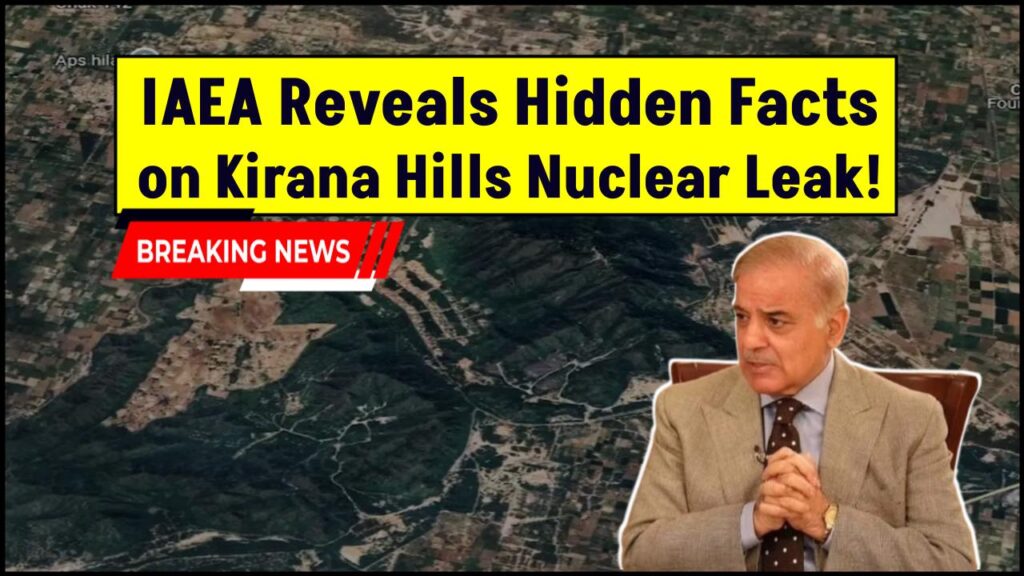IAEA Reveals Hidden Facts: In recent weeks, the term “Kirana Hills Nuclear Leak” has gained widespread attention across media and social platforms. Concerned citizens, defense analysts, and environmental advocates have been trying to make sense of the rumors and official responses. At the center of it all is the International Atomic Energy Agency (IAEA), which has now stepped forward to clear the air.

Amid swirling rumors about a potential radiation leak in Kirana Hills, Pakistan’s alleged nuclear testing site, the IAEA has officially stated that no radiation leak or incident has been reported. This authoritative clarification is meant to dispel fears that have grown since India conducted Operation Sindoor, a military drill near the region.
IAEA Reveals Hidden Facts
| Feature | Details |
|---|---|
| Location | Kirana Hills, Punjab, Pakistan |
| Alleged Incident | Rumored radiation leak following Indian military operations |
| IAEA Statement | No radiation leak detected or reported |
| Speculation Sources | U.S. DOE aircraft, Egyptian plane with boron, social media |
| Official Dismissals | Indian Air Force and IAEA deny any leak or strike |
| Strategic Importance | Kirana Hills is a suspected underground nuclear site |
| Official Website | IAEA.org |
Despite rampant rumors and rising concerns, there is no evidence to support a nuclear leak at Kirana Hills. The IAEA and multiple defense agencies have categorically denied any such incident. The episode highlights the need for responsible information sharing and reliance on official, credible sources.
What Is Kirana Hills and Why Does It Matter?
Kirana Hills, located in the Sargodha district of Punjab, Pakistan, is widely believed to be one of the most secretive and fortified military zones in the country. According to various defense analysts, this area has been used for nuclear weapons testing and research dating back to the 1980s.
Its importance in South Asia’s nuclear architecture makes any whisper of an incident there instantly alarming, both for regional stability and environmental safety. However, despite its mysterious status, very little public data exists about actual facilities in the region.
What Sparked the Radiation Leak Rumors?
Things took a turn when India launched Operation Sindoor, targeting key Pakistani airbases located near the Kirana Hills region. Although Indian officials confirmed the operation, they clarified that Kirana Hills was not targeted.
Yet, suspicions grew when:
- A U.S. Department of Energy aircraft known for tracking nuclear incidents was spotted in the region.
- Reports claimed an Egyptian military plane delivered boron, a chemical used in nuclear emergency situations.
These unverified reports were amplified by social media, sparking concerns over a possible radiation leak or nuclear event.
IAEA’s Response: Clearing the Air
The IAEA, the world’s top nuclear watchdog, issued a formal statement denying any such leak or event. According to their assessment:
“There has been no release of radioactive material from any Pakistani nuclear facility, including Kirana Hills.” — IAEA, 2025
Their denial is based on data from global monitoring stations, satellite imagery, and direct communications with Pakistani nuclear authorities.
Why Rumors Spread So Fast
In today’s digital world, misinformation spreads faster than facts. A few key reasons why this rumor spiraled:
- Lack of transparency: Since Kirana Hills is highly classified, any speculation is hard to verify.
- Military tensions: Given the India-Pakistan rivalry, any defense activity is closely watched.
- Past precedence: Pakistan has conducted nuclear tests in the past, so the fear isn’t without historical context.
IAEA Reveals Hidden Facts: How to Differentiate Between Fact and Fiction?
To avoid falling for false information, follow these simple verification steps:
1. Check Official Sources
Always verify reports with:
- IAEA
- Pakistan Nuclear Regulatory Authority
- World Health Organization Radiation Safety
2. Look for Credible News Outlets
Stick to high-authority sources like:
- The Times of India
- The Economic Times
- BBC
3. Understand the Science
Even 1 gram of plutonium can be lethal if mishandled, but such materials are heavily guarded and monitored by international systems. False alarms often stem from misunderstanding how radiation and nuclear facilities work.
Practical Advice: What to Do in Case of a Real Leak
Though this case was a false alarm, it’s wise to understand basic nuclear safety tips:
1. Shelter in Place
Find an interior room, close all windows, and seal doors.
2. Stay Informed
Keep a battery-operated radio or trusted app for alerts.
3. Avoid Contaminated Areas
Wait for official instructions before evacuating or going outdoors.
4. Stock Essentials
Keep clean water, non-perishable food, and basic medical supplies handy.
FAQs on IAEA Reveals Hidden Facts
Is Kirana Hills a nuclear site?
While never officially confirmed, experts widely believe Kirana Hills houses underground nuclear infrastructure.
Did India target Kirana Hills in Operation Sindoor?
No. Indian officials confirmed that the site was not targeted during the military exercise.
Was there any radiation leak?
No. The IAEA has confirmed that no radiation leak occurred.
Why was boron allegedly flown in?
The presence of boron, used to absorb neutrons in nuclear reactions, remains unverified and speculative.
Is there a threat to public health?
As of now, there is no credible threat according to all official agencies.





